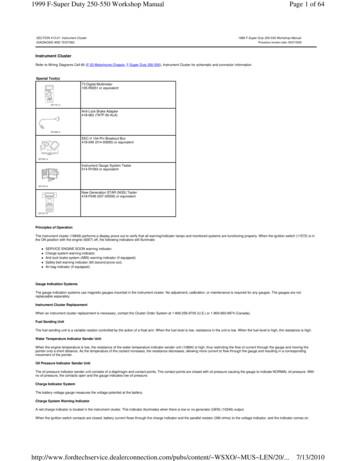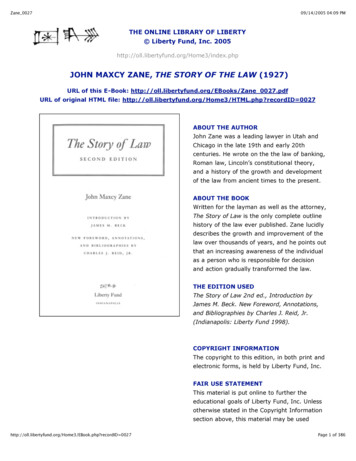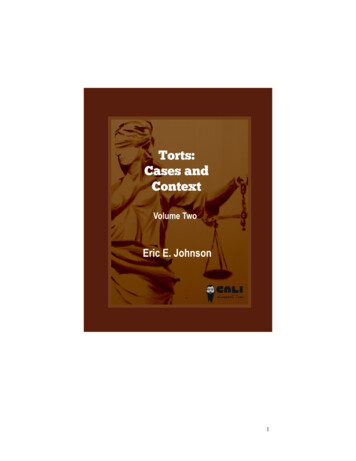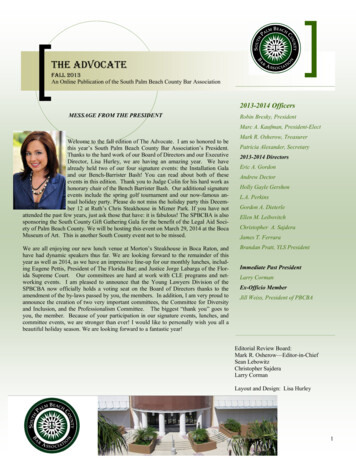
Transcription
International Journal of Pure and Applied MathematicsVolume 120 No. 5 2018, 4123-4135ISSN: 1314-3395 (on-line version)url: http://www.acadpubl.eu/hub/Special Issuehttp://www.acadpubl.eu/hub/LAW AS AN INSTRUMENT OF SOCIAL CHANGE1Sozhiya.S, 2Ms. M. Jayapreethi.1Student , 1st year, BA.LLb(hons), saveetha school of law, Saveetha University,Saveetha institute ofmedical and technical sciences, Chennai-77, Tamil nadu , India.2Assistant professor,M.Sc.,B.Ed.,ML.,Saveetha school of law,Saveetha University,Saveetha institute ofmedical and technical sciences, Chennai – 77, Tamil nadu , India.1sozhi2399@gmail.com , 2jayapreethim.sse@saveetha.comABSTRACT:Law is framed as the standards and rules to be followed for the peaceful living of thepeople in the society , while social change is the alteration in the society which may have eithergood or bad impact in the society.The relationship between the law and social change isdiscussed at a wider aspect. There are various mechanisms being used by the legislation toimplement the rules in the society. It focuses on the way that the law has been implemented andits responses or the effects in the society. Generally they put forth the question that whetherevery law that had been enacted has brought only the good effect and whether the protection ofthe country has been a great concern for the legislation. In the other words, law which isconsidered to be a tool of social change has led to the development of the society or not?.KEYWORDS: Society, social change, law, justice, welfare.LAW AS AN INSTRUMENT OF SOCIAL CHANGEINTRODUCTION:Social change happens because of a few calculates, for example, changes innovation,demography and philosophy, changes in political life and financial strategy and in legitimatestandards or institutions.American Judge Benjamin Cordozo said that the "Last reason for law is the welfare ofsociety". Law ought not be definite but rather should be transformable as per the prerequisite andneed of the general public. The law can't stay unchanging. The analyst is of the view that in achanging society law should walk tuned in to the changed thoughts and philosophies. Social life4123
International Journal of Pure and Applied MathematicsSpecial Issuehas experienced changes in view of correspondence upheaval. Thus to keep in pace with theinnovative improvement, Law must be able for identification of different violations andanticipation of the same moreover. New acts like Information Technology Act has been brought,principles of confirmation has been changed to perceive electronic exchange. Techniques forexpert viding cures have experienced enormous change with the development of electronicbusiness, digital wrongdoing and web.Artificial insemination, unnaturally conceived children, surrogate parenthood andcloning, pre-birth location system and fetus removal have tested the estimations of family life.Aside from these, law assumes a critical part in ensuring the earth. The innovative developmenthas made awesome weight on the corruption of environment. As an outcome of this thelegitimate framework needed to change its lawful techniques and present new standards,regulations, systems and so on to secure nature, human home and the urban life. Innovation is agift and revile, to which law and society need to react appropriately. Aside from society andcondition change additionally occurs in the financial aspects sec-tor, culture religion profoundquality social viewpoint and a lot of regions. Here again law weaves its way through monetarylife making potential outcomes for financial advancement and setting imperatives on the type ofimprovement through a lot of statutes, Ex: Intellectual Property Rights. Thus, the main aim of theresearch paper is to study the nature of law and social change in wider aspect, and to analyse theextent of social change due to the implementation of laws.MATERIALS AND METHODS:The research paper uses the non-doctrinal method which is the simple random samplingmethod. The sample size of the research paper is limited to 300 respondents,due to the limitedtime period available to the researcher. The primary and secondary sources of information wereused. The primary sources of information used are the statutes and legislations and the secondarysources of information used are journal articles, thesis, and working papers.REVIEW OF LITERATURE:Law as per the choice of a small group of ruling individuals, without winning theconfidence of the masses, is bound to fail in its objective,( Friedman.W,1964). Gender equityshould not stop at the law, nor should it be derailed by successes in law,(Mulela MargaretMunalula,1995). Law does not penetrate organisations automatically, without cost or distortion(Catherine Albistan,2001). Law also tended to ignore interdependent relationships (Daniel4124
International Journal of Pure and Applied MathematicsSpecial IssueMandelkar,1970). The three wings of power are independent in (Trishala A , Lakshmi T andRajeshkumar S, 2018)theory but their separation of powers is not rigid, (Abhinav Mishra, 2015).Law is the reflection of the will and wish of the society,(Swapna mukhopadhyay,1998). Theimplications of norms and customs make the social change,(Franklin Zimring,1971). Some socialproblems grow more interactable and complex,( Thelton Henderson,2003). Even though judgesmay be guided by common sense or logic, they are not ruled by it, (David,1975). Legaldevelopment is much a rational response or is a political, natural response to the existingcircumstances, (Prasidda,2012). Many countries are implementing legal and(Dr.Lakshmi Tand Rajeshkumar S , 2018) judicial reforms as part of their overall development programs,(MariaBakolias,2000). Increasing numbers and fear of “bureaucratisation” of the Judiciary have createdproblems in recruitment,(Frank upham,2005). Supreme Court remarkably contributes for welfareof the society particularly the deprived people,(Puneet Pathak,1997).The judicial activism inrelation to social change is really contradictory in nature,(Arpita Saha,2008). Legal advocacygroups became largely isolated from the rest of the movement,(Holly Mc cammon,2015).CONNECTION AMONGST LAW AND SOCIAL CHANGE:The analyst is of the conclusion that law is the best instrument of social changehowever now and again social changes progresses toward becoming law. In India there are twoprinciple foundations which rolls out improvement in law, to be specific the lawmaking bodywhere new laws are sanctioned or alterations are done to the old demonstrations to suit the needof great importance. The second foundation is our legal, where understanding of the manage ofland and law of land exist together. Law ought not be definite but rather should change as per theprerequisite and need of the general public emerging out of taking a break. It is this prescience atthe top of the priority list father and fundamental designer of the Indian Constitution Dr.BhimaRao Ambedkar embedded Art 368 to the constitution which gives that "Any piece of the constitution might be revised by embracing suitable strategy with the exception of obliterating theessential structure of the constitution". It reflects the acknowledgment of the need of changingthe law even the rule that everyone must follow when circumstance warrants.NEED OF CHANGING LAW:Indian legal has for the most part been observed to be alive to the requirements of socialreasoning. The courts have brought and their new ramifications and added new measurements tothe law.As properly cited by Justice P N Bhagwati "the judge mixes life blood into the dry4125
International Journal of Pure and Applied MathematicsSpecial Issueskeleton gave by the legislature and makes a living being fitting and satisfactory to address theissues of the general public". To demonstrate the instrumentality of law on social change, it isimportant to consider some uncommon changes that have occurred in India, since nothing ispermanent except for change is lasting.DISALLOWANCE OF CHILD MARRIAGE:This routine with regards to tyke marriage was passionately found in Indian culturecrosswise over different religious groups. Extreme endeavors were made by numerous reformersit turned worthless until the point that a law was ordered. The Hindu Child Marriage RestraintAct was substituted by the restriction of Child Marriage Act 2006. It introduction ducedyoungster marriage restriction officer and expanded the energy of family court to choose theissue under the Act. The demonstration likewise improved the discipline upto two years thoroughdetainment or with fine up to Rs 2 lakhs or with both.RIGHT TO FREE AND COMPULSORY EDUCATION:In 1992 the good Supreme Court proclaimed the privilege to free and mandatoryinstruction as a key right in the ambit of 'Ideal to Life' under Art 21 of the constitution. In 2002the constitution was changed by embeddings Article 21A to execute the privilege to free andmandatory instruction of each kid matured between 6–14 years and embedded principalobligations of parent and gatekeeper3. In 2010 The Right of Children to Free and CompulsoryEducation Act 2009 was placed in drive with impact from first April to give free and mandatoryinstruction from 1 to eighth standard to each tyke. Along these lines it can be seen that lawgenius texts the life of the youngsters.PUBLIC INTEREST LITIGATION:The Honorable Supreme Court has received the more extensive approach of the manageof locus standi to use the activity and arrangement people in general vivacious people to movethe courts to represent the general or gathering interest despite the fact that they may not bespecifically harmed in their rights. The most imperative truth in regards to PIL is that ofunwinding the locus standi idea, any open vivacious per-child can approach the establishedcourts and could convey to the courts notice of obtrusive infringement of Fundamental Rights ofindividuals who are not fit for being moving toward the courts themselves4. PIL is an idea wentfor expanding the accessibility to equity and structures a piece of sacred law in India.4126
International Journal of Pure and Applied MathematicsSpecial Issue3. Constitution of India, by P.M.Bakshi4. Report of India, 2002.LAWS FOR RAPE VICTIMS:The administration passed the statute on April 21 following across the board dissentsafter endeavors by a few pioneers and supporters of the decision Bharatiya Janata Party (BJP) tosafeguard Hindu culprits of the kidnapping, abuse, assault, and murder of a 8-year-old Muslimtyke in Jammu and Kashmir state. In Uttar Pradesh state, experts not just neglected to capture aBJP administrator blamed for assaulting a 17-year-old young lady, yet in addition supposedlybeat her dad to death in police guardianship.The Criminal Law (Amendment) Act, 2013,included new classes of offenses with respect to savagery against ladies and young ladies andmade discipline more stringent, including capital punishment for rehash guilty parties.PUBLIC OPINION ON RECENT LEGISLATIONS:Among 300 respondents, 90% were between the age of 18-25, and 10% were below 18 years. Asmost of the respondents were youngsters, their approach towards the social change is notable.4127
International Journal of Pure and Applied l Issueandtherestwerefemale.Out of 300 respondents,36.7% feel that there is political change in recent times, 16.7% state thatthere is economic change in recent times, 0.5% state that there is Judicial change in recent times,0.4% state that there is religious change in recent times and 36.7% state that there is economic,political, Judicial, religious changes in recent times.Out of 300 respondents, 44.8% of the respondents were aware of the legal provisions for thesocial change, 4.5% were not aware of the legal provisions for the social change and 51.7% lchange.
International Journal of Pure and Applied MathematicsSpecial IssueOut of 300 respondents, 39.3% state that the agricultural issues are the burning issues of ourcountry,25% state that basic necessities are the major issues of our country, 32.1% state that childabuse is the burning issue of our country and the rest feel that sterlite is the major issue of ourcountry.Out of 300 respondents, 37.9% state that the social changes are not only due to theimplementation of laws, 24.1% state that social changes are only due to the implementation oflaws and 37.9% state that the social changes may be due to the implementation of laws.Out of 300 respondents, 25% state that change of law will be the solution for agricultural issues,17.9% state that increase in subsidy for seeds is the solution, 53.6% state that increasing irrigation4129
International Journal of Pure and Applied MathematicsSpecial Issuefacilities will be the solution and the rest state that sufficient agricultural lands will be ten solutionfor the agricultural issues.Out of 300 respondents, 60% state that there is negative social change, 26.7% state that there ispositive social change and the rest state that they have no idea about the social change.Out of 300 respondents, 44.4% do not accept law to be an instrument of social change, 37% statethat law is the instrument of social change and the rest state that law may be the instrument forSocialchange.Out of 300 respondents, 70.4% state that the present provisions of law is not satisfactory and29.6% state that the present provisions of law that leads to social change is satisfactory.Out of 300 respondents, 82.1% state that punishments need to be made severe to the rapeaccused, 7.1% state that change of law will be the remedy for the rape victims and the rest state4130
International Journal of Pure and Applied MathematicsthatchangeinwomennatureandotherSpecial Issueremedieswillpreventrape.Out of 300 respondents, 53.6% were not much aware of all the governmental policies, 7.1% wereaware of all the governmental policies and 39.3% were not aware of all the governmentalpolicies.Out of 300 respondents, 42.9% state that the social change do not affect any foreign relationshipof our country, 32.1% state that social change may affect the foreign relationship of our countryand 25% state that the social change will affect the foreign relationship of our country.Out of 300 respondents, 53.6% state that change in Government will be the remedy for negativesocial change, 14.3% state that change in law will be the remedy for negative social change and4131
International Journal of Pure and Applied MathematicsSpecial Issue32.1% state that change in mindset of the people will be the remedy for negative social change.Out of 300 respondents, 75% state that law has not fulfilled its duty in case of unemployment ofgraduates, 21.4% state that they have no idea about the unemployment issue and the rest statethat the law has fulfilled its duty in case of the unemployment of graduates.CONCLUSION:Thus, social issues are interconnected as opposed to separated and law is a mirror to know howpeople are identified with each other. Successful execution of law as an instrument or gadget ofsocial change should work in tandem with social and social existence of individuals of India.Change of social framework as per the need of the circumstances and as per the modes andmores of the people involves need. A striking harmony between instru-attitude of law andfolkways and mores of the general population would truly clear route for genuine equity in reallife and in this manner prompts empowerment of the society.REFERENCES:1.Friedman,2.Mulela Margaret munalula, the constitution and sexual discrimination in ol.1,issue.2,1995.Albiston, Catherine R., and Gwendolyn M. Leachman. "Law as an Instrument of SocialChange." International Encyclopedia of the Social & Behavioral Sciences (2015): 542-49. Print.4.Dr.S. Durgalakshmi, social change and empowerment of the masses, Indian journal ofApplied research, vol.5, issue.12,2015.5.Abhinav Mishra,law and liberty: A tug of war, Indian journal of law and liberty, vol.1,issue.1,2015.6.Mandelker, Daniel R. "The Role of Law in the Planning Process." Law andContemporary Problems 30.1 (1965): 26.4132
International Journal of Pure and Applied Mathematics7.Special IssueSwapna mukhopadhyay, The feminist dilemma, Manohar publishers and distributors,1998.8.Divya, law as an instrument of social change, IOSR Journal, vol.3, issue.9,1999.9.Zimring, Franklin, and Gordon Hawkins. "The Legal Threat as an Instrument of SocialChange." Journal of Social Issues 27.2 (1971): 33-48.10.Thelton Henderson, social change: judicial activism and the public interest lawyer,journal of law and policy, vol.12,2003.11.Pandey, Prasiddha. "Judicial Review in Supreme Court and Social Change -- ImplicatingChanges Through Judiciary." SSRN Electronic Journal (2012).12.David, judicial reasoning and social change, Indana law journal, Vol.50, issue.2,1975.13.Maria bakolias, legal and judicial development,Fordham International law journal,vol.24,issue.6,2000.14.Upham, Frank K. "Political Lackeys or Faithful Public Servants? Two Views of theJapanese Judiciary." Law and Social Inquiry 30.2 (2005): 421-56.15.Hakeem yusuf, the judiciary and political change in Africa, Oxford journals,vol.7,issue.4,1997.16.journal17.Puneet Pathak,Acceptability of judicial activism in India perspective, ssue.3,1998.T.C.Anant, An Economic analysis of judicial activism,Economic and political weekly,vol.37,issue.43,2002.18.David weisen, judicial politicisation,ideology and activism at the High courts, sageJournal,vol.64,issue.2,2010.19.Mccammon, Holly J., and Allison R. Mcgrath. "Litigating Change? Social Movementsand the Court System." Sociology Compass 9.2 (2015): 128-39.20.Saha, Arpita. "Judicial Activism in India: A Necessary Evil." SSRN Electronic Journal(2008).21. Dr.Lakshmi T and Rajeshkumar S , “In Vitro Evaluation of Anticariogenic Activity of AcaciaCatechu against Selected Microbes”, International Research Journal of Multidisciplinary Science &Technology, Volume No. 3 , Issue No. 3, P.No 20-25, March 2018.4133
International Journal of Pure and Applied MathematicsSpecial Issue22. Trishala A , Lakshmi T and Rajeshkumar S, “ Physicochemical profile of Acacia catechu bark extract–An In vitro study”, International Research Journal of Multidisciplinary Science & Technology, VolumeNo. 3 , Issue No. 4, P.No 26-30, April 2018.4134
4135
4136
Mandelkar,1970). The thre e wings of power are independent in (Trishala A , Lakshmi T and Rajeshkumar S , 2018 )theory but their separation of powers is not rigid, (Abhinav Mishra, 2015). Law is the reflection of the











